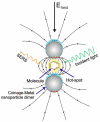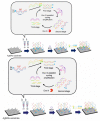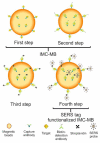A Review on SERS-Based Detection of Human Virus Infections: Influenza and Coronavirus
- PMID: 33670852
- PMCID: PMC7997427
- DOI: 10.3390/bios11030066
A Review on SERS-Based Detection of Human Virus Infections: Influenza and Coronavirus
Abstract
The diagnosis of respiratory viruses of zoonotic origin (RVsZO) such as influenza and coronaviruses in humans is crucial, because their spread and pandemic threat are the highest. Surface-enhanced Raman spectroscopy (SERS) is an analytical technique with promising impact for the point-of-care diagnosis of viruses. It has been applied to a variety of influenza A virus subtypes, such as the H1N1 and the novel coronavirus SARS-CoV-2. In this work, a review of the strategies used for the detection of RVsZO by SERS is presented. In addition, relevant information about the SERS technique, anthropozoonosis, and RVsZO is provided for a better understanding of the theme. The direct identification is based on trapping the viruses within the interstices of plasmonic nanoparticles and recording the SERS signal from gene fragments or membrane proteins. Quantitative mono- and multiplexed assays have been achieved following an indirect format through a SERS-based sandwich immunoassay. Based on this review, the development of multiplex assays that incorporate the detection of RVsZO together with their specific biomarkers and/or secondary disease biomarkers resulting from the infection progress would be desirable. These configurations could be used as a double confirmation or to evaluate the health condition of the patient.
Keywords: COVID-19; SERS; anthropozoonosis; coronavirus; influenza; quantification strategies; virus; zoonosis.
Conflict of interest statement
The authors declare no conflict of interest.
Figures















Similar articles
-
SERS Platform for Integrated Enrichment, Isolation, and Identification of Multiple Respiratory Viruses in a Single Assay Using 3D Stereoscopic SERS Tags and Flocked Swabs.Anal Chem. 2024 Aug 13;96(32):13042-13049. doi: 10.1021/acs.analchem.4c01243. Epub 2024 Aug 2. Anal Chem. 2024. PMID: 39092994
-
Miniaturized Raman Instruments for SERS-Based Point-of-Care Testing on Respiratory Viruses.Biosensors (Basel). 2022 Aug 2;12(8):590. doi: 10.3390/bios12080590. Biosensors (Basel). 2022. PMID: 36004986 Free PMC article. Review.
-
Multichannel Immunosensor Platform for the Rapid Detection of SARS-CoV-2 and Influenza A(H1N1) Virus.ACS Appl Mater Interfaces. 2021 May 19;13(19):22262-22270. doi: 10.1021/acsami.1c05770. Epub 2021 May 9. ACS Appl Mater Interfaces. 2021. PMID: 33966371
-
Multiplexed lateral flow immunoassays using high photostability gap-enhanced Raman nanotags: Highly sensitive, rapid, efficient and portable point-of-care tests.Biosens Bioelectron. 2025 Jun 15;278:117377. doi: 10.1016/j.bios.2025.117377. Epub 2025 Mar 14. Biosens Bioelectron. 2025. PMID: 40107069
-
SERS Based Lateral Flow Immunoassay for Point-of-Care Detection of SARS-CoV-2 in Clinical Samples.ACS Appl Bio Mater. 2021 Apr 19;4(4):2974-2995. doi: 10.1021/acsabm.1c00102. Epub 2021 Mar 17. ACS Appl Bio Mater. 2021. PMID: 35014387 Review.
Cited by
-
Recent Development and Applications of Stretchable SERS Substrates.Nanomaterials (Basel). 2023 Nov 17;13(22):2968. doi: 10.3390/nano13222968. Nanomaterials (Basel). 2023. PMID: 37999322 Free PMC article. Review.
-
Nucleic Acid-Based Nanobiosensor (NAB) Used for Salmonella Detection in Foods: A Systematic Review.Nanomaterials (Basel). 2022 Feb 28;12(5):821. doi: 10.3390/nano12050821. Nanomaterials (Basel). 2022. PMID: 35269310 Free PMC article. Review.
-
A Direct Immunoassay Based on Surface-Enhanced Spectroscopy Using AuNP/PS-b-P2VP Nanocomposites.Sensors (Basel). 2023 May 16;23(10):4810. doi: 10.3390/s23104810. Sensors (Basel). 2023. PMID: 37430723 Free PMC article.
-
Advancements in Testing Strategies for COVID-19.Biosensors (Basel). 2022 Jun 13;12(6):410. doi: 10.3390/bios12060410. Biosensors (Basel). 2022. PMID: 35735558 Free PMC article. Review.
-
Emerging nanophotonic biosensor technologies for virus detection.Nanophotonics. 2022 Dec 1;11(22):5041-5059. doi: 10.1515/nanoph-2022-0571. eCollection 2022 Dec. Nanophotonics. 2022. PMID: 39634299 Free PMC article. Review.
References
-
- Siddiqui O., Manchanda V., Yadav A., Sagar T., Tuteja S., Nagi N., Saxena S. Comparison of two real–time polymerase chain reaction assays for the detection of severe acute respiratory syndrome–CoV–2 from combined nasopharyngeal–throat swabs. Indian J. Med. Microbiol. 2020;38:385–389. doi: 10.4103/ijmm.IJMM_20_279. - DOI - PMC - PubMed
-
- Mustafa M.A., AL-Samarraie M.Q., Ahmed M.T. Molecular techniques of viral diagnosis. Sci. Arc. 2020;1:98–101.
Publication types
MeSH terms
LinkOut - more resources
Full Text Sources
Other Literature Sources
Medical
Miscellaneous

